ACKNOWLEDGEMENTS
It takes a lot of research to write award-winning historical novels. I created the below Fairbank Main Street business directory to help me identify the earliest people and places that made up the village of Oxbow (loosely based on Fairbank, Iowa). Gangster in Our Midst tells the story of Prohibition in the 1920s-30s; The Black Bag of Dr. Wiltse tells an earlier (mid-1850s) piece of the gangster story. Book three in the series will be available in late 2023.
I’ve provided the list (below) to aid readers who have asked for more information about my hometown.
Thank you to the myriad individuals (locals) who helped with this accounting. Note: Where a family member of a specific business could not be reached, I re-published the history of a business from the 1976 Fairbank Times Bicentennial Newspaper. Members of the Fairbank Historical Society were invaluable resources, too. I continue to conduct research and update the list. (Last update: 2023-05-03)
Thus, this directory is not intended to be a comprehensive list of Fairbank history, and any inaccuracies are wholly unintentional, the result of incomplete or incorrect available documentation, fading memories of contributors, and/or perhaps…a bit of nostalgia bout ‘a time that was.’
Betty Brandt Passick
——————————————————————————————————————–
William S. Clark, a native to New York, made the first permanent settlement in this township in 1849. Clark served as the first magistrate and clerk; he also served as one of the pioneer teachers. Justus A. Durham, who settled in this township in 1852, became the first Justice of the Peace. James Patchen and Jud Duffy served as constables, operating out of a building on East Main Street (just south of the former Chapman Lumber at the corner of Fourth and Main Streets). William S. Clark relocated to California in 1858.

F. J. Everett, also a native of New York, and C. W. Bacon, who accompanied Everett, platted the north part of the township in 1854. Initially they called the village Alton, then Fairbank (Bacon’s grandmother’s name was Fairbank). Bacon eventually became dissatisfied with life in the west and in 1860 returned to New York.
On March 5, 1855, the village was organized as a separate and independent township, with about 400 inhabitants. The area was about three-fifths timberland, and the rest fertile prairie. The plat consisted of the territory of North section Five, Township Ninety, Range Ten, West of the 5 p.m., except a strip 70 rods wide on the west side of the said description, including the town plat of Fairbank (east of the river), and Conables (west of the river). The Patterson Addition (south of the railroad tracks) became the first addition to the original plat, named after Frederick Patterson, the first mail carrier. The county was named Buchanan, after James Buchanan, the 15th President of the United States (s. 1857-1861).
Early pioneers in the township included: Alexander Stevenson (1850); Robert Wroten (1851); Justus A. Durham (1852); Jacob Minton (1852); J. M. Soper (1852); Jordon Harrison (1853); George Beatty (1853); and Frederick Patterson (1854).
John McCunniff is believed to have started the first store in 1855. The lumber came from oak logs sawed at the Everett and Bacon saw mill, at about the location of the (current) swing (foot) bridge to the island.
The first to establish farms in the township (many still owned by family members a century later), included: John Goeller (1852)—Herbert Goeller Century Farm; E. W. Wellman (1853); Elisha Sanborn (1854); I. B. Agnew (1855); D. W. Hopkins (1855); Cyrus Taylor (1855)—Gordon Neil Century Farm; John and Madlin Kerns (before 1856)—Leo Beierschmidt Century Farm; John and Ameilia Hodgdson (before 1856)—Dale and Diane Neil Century Farm; Fredrich and Pauline Kraft (1856)—Paul Kraft Century Farm; John Donnelly (1857)—Marie M. Donnelly Century Farm; Asa B. and Margaret Clark (before 1859)—John and Irene Shields Century Farm; Barnard Shields (1859); Francis and John Kerns (before 1860)—Larry L. Bockholt Century Farm; Herman and Eliza Morse (before 1861)—Wayne and Arnola Siggelkow Century Farm; Hiram Baleom (before 1863)—Ray and Beverly Kane Century Farm, O. P. King and his brother C. E. King (1864), Jeremiah S. West (before 1865)—Gene and Evonda Niebuhr Century Farm; John Kerns (before 1866)—Henry Reiter Century Farm; Joel and Lucia Nurse (1867); Barnard and Elizabeth Sweeney (1871)—Wendell and Norma Goeller Century Farm; James and Amelia I. Watson (before 1974)—Arthur Trebon Century Farm; Theodore and Philemon Dodge (before 1875)—Loren Gallup Century Farm; Milo L. Higby (1881); Asa Blood Jr, Elzey Wilson; Richard Cambell and P. S. Canfield (1899)—Lowell and Kathryn Connell Century Farm.
On May 5, 1891, the first election in the township was held in the basement of the Methodist Episcopal Church. The first councilmen included: Mayor, J. C. Myers; Clerk, P. F. Damge (1865-1920); John W. Walgamot, (1862-1925), marshal; C. H. Green; C. M. Roberts, assessor. Councilmen included: M. L. Higby (1830-1899); C. H. Kuenzel; J. M. Walgamot; C. B. Everett (1955-1926); N. E. Fairbrother; and S. J. King (1835-1917).
Charles William (Bill) Hahn (1879-1862) served as town marshal from 1916-1949.
In 1929 the town erected a city building, jail, and engine house; a water system was installed around 1931. Initially the town connected water to businesses, then households—some not getting hooked-up until the ‘40s. When Main Street was paved in 1947, the road surface was lowered by about a foot; the flag pole (previously set in the center of the street at Second and Main Streets) went to the grassy area east of the (current) Post Office. The storefront boardwalk, too, was replaced by a concrete sidewalk.

— Indian Town, also known today as City Park, is located in the Addison edition in the southeast part of town — perhaps named because of the large numbers of American Indians (Sioux, Fox and Ojibwe) that used the area as a temporary settlement. It became the site for the Civil War (1861-1865) monument, erected in 1911.
— The Island Park is a part of the original 43.51 acres which Albert Clark acquired from the government in 1852. Everett and Bacon bought the land in 1854, and thereafter changed hands many times, continuing to be recorded as Mill property until the early 1900s. At the turn of the century, the first pontoon bridge was built, giving access by foot to the island for baptismal ceremonies, picnics, and church activities. Eventually, the pontoon bridge washed out. In the early 1930s, Charles Grantham designed and built a hanging foot bridge, and for a number of years promoted boxing matches on the island. On May 16, 1938, the owner deeded the island and surrounding land to the American Legion, who in turn, deeded it to the town of Fairbank to be used as a park.
— Main Street Bridge: The first bridge to cross the Little Wapsipinicon River (southern leg), connecting the east and west sides of Fairbank, was washed out in 1865 during spring flooding, according to The History of Buchanan County, 1816-1902 (p 341). The first mill was also lost. Additional bridges were built over the years — all soon lost in subsequent years from spring flooding. To solve this problem, the roadway and boardwalks on Main Street eventually were raised. The most recent bridge replacement occurred in 1955.
Numerous drowning deaths happened over the years, including: 1) Ludwig Miller, age 66, while bathing with his wife (she survived) on Aug. 26, 1906. 2) The son of A. A. Pooler who fell while walking across the plank to the dam flume. 3) A gentleman from Dunkerton, while trying to rescue two children (saving the children) who had stepped into a deep hole in the late 1930s-early 1940s. 4) And, Henry Trebon, who fell into the river south of the bridge in the early 1950s.
BANKS
— Fairbank State Bank, originally Citizen’s Bank, a private institution, established in 1891, was chartered on May 24, 1897. Clarence B. Everett was one of its founders. The first officers were: F. W. McNeely, President; Charles Higbee, V. P; and W. F. Treadwell, cashier. Eventually, C. B. Everett (1855-1926) became president; G. W. McNeely, vice president; W. L. Murphy, cashier; A. H. Nieman, teller; F. W. Fox, bookkeeper. Clarence B. Everett (1855-1926) remained president until his death. His obituary states he was the first white child born in Fairbank Township. In 1930, A. H. Nieman became president and major stockholder in the bank.
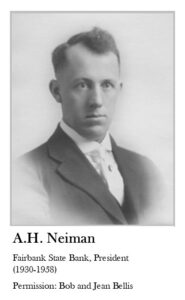
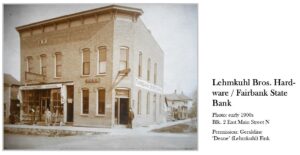
— Farmers State Savings Bank was established May 24, 1910, after buying out the Bank of Fairbank, a private institution owned by J. I. Minkler, located on the southwest corner of Second and Main Streets. Lewis Shoenut helped incorporate the bank and became its first president, with C. H. Kuenzel, V. P., and G. F. Monroe, cashier. The bank offered general banking, farm loans, and insurance under the management of A. P. Considine.
In 1916, upon completion of a new two-story brick building on the southeast corner of First and Main Streets, the bank moved. For many years, the second floor was rented to various associations: the Pythian Sisters; Knights of Phythias; Masons, Brethren of Fairbank, Lodge 148, A.F.&A.M. (1860); Chapter OES 516 of Eastern Star (1922), Ancient Order of United Workmen; (1881), and American Legion, Fortsch-Duffy Post 552 (1919).
In the early-1920s, the officers included: O. F. Leonard, president; John Corcoran, V. P.; L. P. David, cashier; and Mary Schumacher, teller. Its directors were: O. F. Leonard, John Corcoran, L. P. Davis, John Woods, Ed Gallup, E. A. Kraft, H. Siggelkov, A. J. Shannon and Thos. Shields—all farmers from the Fairbank community. The Wall Street Crash of 1929 contributed to the Farmers bank going into receivership on December 9, 1931.
In 1934 the building was purchased by Robert Bentley and converted into a mill. Earl Johnson then purchased the property and operated the mill for another ten years.
BARBER SHOPS
— A. T. Considine is believed to have operated the first pioneer barber shop in Fairbank around 1896.
— Frank Dewald operated a barber shop in town around 1917.
— ‘Fats’ Barber Shop, established in 1933, was owned by Arnold ‘Fats’ and Gertrude Coffin (she ran a café on one side of the establishment). Initially, the businesses were located in the old Post Office building on the south side of Main Street. Both businesses eventually relocated to the opposite side of the street (219 Main Street).
BLACKSMITHS/HARNESS-MAKERS
— Miller Blacksmith was established by Louis T. Miller on March 17, 1883 (St. Patrick’s Day). Initially, the business was located between the Old Mill and the Opera House, next to the Main Street bridge (north side); later the business moved to the south side of Main street, operated by Bill and Frank D. Miller (1915–1984).
— Kraft Harness was established in the early 1900s, owned by August G. Kraft, harness-maker, located in the building west of B & R Motor Service, located on the southwest corner of Second and Main Streets.
CAFES
— Bon Ton (restaurant and confectionary), operated by T. K. (Ed) Allen. Ed’s son, Wayne, used to go into street in the 1900s to ring a bell at mealtimes, which was served family-style, all you could eat, for fifty cents. Harvey Higby first purchased the land in 1864, and owned it until 1934, when William and Alice Murphy bought the building. It’s believed the Murphys added a gas station sometime after 1934.
— Coffin Café: From 1933-1947 Gertrude Coffin operated the café located on the east side was a barber shop (operated by her husband, Arnold ‘Fats’ Coffin).
CEMETERIES
— Kier-Union Cemetery, located west of the intersection of Dillon Ave. and 140th Street — also known as Wilbur Cemetery and Kier/Union Cemetery, contains over one hundred burials. According to a sign posted at the cemetery, in 1859 there was a small settlement known as Triumph located on a stagecoach trail. James and Minerva Minton filed a surveyor’s plat of one acre of land as “Union burying ground” and dedicated the land to public use as burying ground (cemetery is about 100 yards west of the sign). Burials include several children, Civil War veterans, and early settlers of the township. Among them is Justice A. Durham, Fairbank Township’s first Justice of the Peace. The first post office in the township was also at Kier, abolished June 30, 1902.
— Fairbank Cemetery: The Protestant cemetery was added north of St. John’s Lutheran Church.
— Immaculate Conception Catholic Cemetery was established on the northwest side of the Wapsie River in Fairbank Township around 1870.
CHURCHES/SCHOOLS
— The Free Will Baptist Society was organized in 1859 with about eighteen members. The first members were James Sanborn, J. A. Durham and wife; S. P. Cramer; Morrill Sanborn; E. Sanborn; Deacon Norris and wife; and Jason Nichols and wife. In 1881 two lots on the corner of east Grove (initially named Residence Street) and Fourth streets were purchased from J. C. Myers for $100. Church construction began immediately, but materials had to be hauled from distant towns, as there was no railroad yet running through town. The house of worship was finally completed in 1882. Having no parsonage, the first pastor, Rev. Kayser, lived in a rented house provided by the congregation until 1888, when a parsonage was built west of the church. In 1893, the first full-time pastor was called, the Rev. Thomas McElroy. In 1910, Free Will Baptists consolidated with the Baptists, and the church became First Baptist Church. In 1914, a basement was dug and the church underwent a remodel. The church celebrated 75 years in 1934.
Pastors have included: Rev Paul (1888), who increased member from 39 to 110; Rev. H. L. Maltman (1888-May 1890); Rev. D. A. Shaw (1891); Rev. McMinn (1903); Rev. H. E. Cross (1896); Rev. Powell (1897), Rev. J. A. Cochran (1907); Rev. A. Van Benschoten (1924-1929); Rev. C.V. Phillips (1929-1930); Rev. L.O. Agnew (1930-1931); Rev. Clair J. Brown (1932-1935); Rev. J.S. Schroeder (1935-1936); Rev. G. A. Thomas (1937-1943); Rev. Clarence Soden (1943-1945); Rev. Howard Robinson (1945-1946); Rev. Clarence Soden (1946-1948); Rev. Merlin Hansel (1948-1953); Rev. Donald Hager (1953-1957); Rev. Richard Milne (1957); Rev. Dan Bean (1957-).
— Immaculate Conception Church, Roman Catholic
Pope Gregory XVI created the diocese of Dubuque in the Territory of Wisconsin in 1837. In 1858 the first mass was offered in the McCunniff schoolhouse. Father Shiels, the resident priest of Waverly at the time, was the first to attend the Fairbank society. He was succeeded by Father John Gosker, of Independence. The first priest to settle here was Eugene Sullivan. In 1868, the church was built at 302 W. Main Street using stones from the six-acre lime quarry on the southern part of the property (John Beierschmitt and Henry Trebon traded a team of horses for the quarry, and eventually the Trebons donated the quarry to the church). John Beierschmitt, who had been a builder and stonecutter in Germany, was among those that helped build the new church. In September 1896, the first school-convent building was constructed offering three classrooms: primary, intermediate, and upper; the latter grades prepared students to take their examinations for teaching certificates. The school was taught by nuns from the Presentation Order in Dubuque. Mary Schmit (1879-1937) graduated in 1898. She is buried in the Catholic Cemetery. Her parents were Joseph and Mary Catherine (Kauten) Schmit.
The first rectory, where the priest lived, was built in 1915. After the school fire in December 1916, classes were taught in an unused store in the town, until a new brick rectory-school was constructed (1917). Nine members graduated from the first class in 1917, including Alice Shields, Gertrude (Gardner) Miller, Vera (Peters) Wieland, Sister Charles Miller, Charles Corkery, and Mary (Welsh) Pearl. In May 1923, the I. C. High School obtained accreditation from the Iowa Committee on Secondary Schools. Kindergarten was added in 1933. Father Halpin added the drive to the south side of the church in 1929. Father Torpey begin the ‘envelope system’ in 1935–the same year stokers for coal were added to the rectory, school and convent. Catholic children received their First Holy Communion at seven years of age, and were Confirmed at ten years.
Since the mid-1920s, the I. C. school had a boys’ baseball (and basketball) team, which competed against Oran, Dunkerton and Hazelton public schools, and Oelwein Sacred Heart, with the priest serving as coach. According to long-time member Leo Beierschmitt, baseball for I.C. home games were played on the baseball diamond at the public school until the late 1930s, when the church finally built its own diamond south of the lime quarry.
The earliest priests included: Fr. John Q. Halpin (1915-1931); Fr. W. J. Torpey (1931-1952); Fr. Bernard G. Collins (1952-1966).
— German Lutheran: The Lutheran church in America was started shortly after the first Saxon and other German immigrants arrived in 1847 and established a new church body: the German Evangelical Lutheran synod of Missouri, Ohio and other states. Formal theological training, hymnals, catechisms and other materials followed. About 1854-1855 the first German Lutherans came to Fairbank. Initially they met in their homes, then the public schoolhouse. The Lutheran Society in Fairbank was organized on November 18, 1868—and the first permanent house of worship built in 1865, with twenty-seven members. The church and parsonage were valued at one thousand dollars. The first preacher to attend this society was Mr. Buckrer, with the Christian Day School first taught by the pastor. The religious services were conducted in the German language. The congregation outgrew its facilities and a new church was built in 1891; the first building reverted to a parochial schoolhouse (which yet stands west of the church). The first hired teacher was Mrs. Adoline Friedrich Steggall (s. 1924-1925). Gerhardt Potratz (1907-1975) also taught in the Lutheran school for many years. Miss Fern Lange (1921-1995) replaced Mr. Potratz.
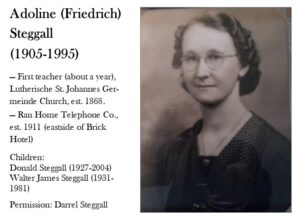
The central section and entry of the present church is part of the original structure. The 50th anniversary of the church was celebrated in 1920 rather than 1918 because of the Great War. In 1919 the first service was held in English, and at that time a new parsonage was dedicated. On May 25, 1936, the ground was broken for a 20-foot extension on the west end of the church, and full basement was dug.
On January 28, 1944, the name of the church was changed from the Lutherische St. Johannes Germeinde Church toSt. John’s Evangelical Congregation of Fairbank, Iowa.
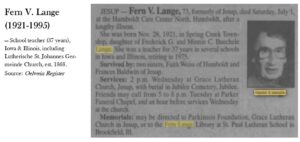
— The Methodist Episcopal Society was organized in 1864 with eight members, believed under the leadership of George Beatty, a Protestant Methodist preacher, who settled in the central part of the township in the fall of 1853. He built a stone church at Fairbank village, mostly with his own means. He died some years later; his wife lived with her daughter Mrs. J. Harrison. In 1867, the old stone Protestant Episcopal church, as it became called–also utilized by area Presbyterians, had a class of thirteen.In 1870, the Methodist Episcopal Church was built (with the aid of the Presbyterians), on South First Street. The steeple was added in 1878, thanks to the Ladies Aide Society. A large addition followed later that included a full church basement, kitchen and fellowship hall on the ground floor, and six classrooms upstairs. The church was reconstructed in the summer of 1900 and rededicated by Dr. Benton, president of Upper Iowa University October 28th. On November 8, 1942, the structure was completely destroyed by fire. Construction of a new brick church at 107 N. Second Street happened in 1943.
The first pastors included: Rev. H. W. Artman (s 1917-1919); Rev. Walter Edie (1921); Rev. O Sandbach, third year (s 1920-1924); T. J. Elwick (s 1925); Floyd Maynard (1928-1930); M. W. McKinley (1931): Oelfke (fall 1931-1936); M. W. McKinley (spring 1937); W. G. Barr (fall 1937); W. G. Barr and C. C. Winter (1937-1943).
Today the church is known as Fairbank United Methodist Church.
— The Presbyterian Church was organized in the township in 1856 at what was called the old Stone Protestant Episcopal Church with six members. One of the founders was Alexander Stevenson, who came from Indiana in September 1850. Among its members were: F. Everett, C. W. Bacon; James Sankey and wife; J. C. Stevenson; and Robert Wroten. The first pastor, and the one to whom a great deal of credit is due for the organization, was J. D. Caldwell. The lack of members compelled the disbandment of this congregation. The last service was held about 1898.
Country Schools
— Fairbank Public School: In 1855, a year after the village of Fairbank was laid out, a large two-story building was built on the west side of the river on a plot of ground that is now 103 Walnut Street N. It was one of eight schools in the Fairbank township. The school had two teachers and about two hundred students. The teachers were: Sadie King, Primary; Lizzie Hitchcock, Intermediate; Charlie Everett, Principal; and J. H. Williams, Superintendent. Pat McCunniff graduated in June 1905; Wilbur Finch and Mae (Moore) Elliott in 1907.
The building was replaced in 1917, when a new three-story brick building was erected on the east side of the river at 505 Forest Street. Mrs. Martha Minkler donated a six-acre tract of ground for the site. At a cost of $38,000, the building had eighteen rooms and employed seven teachers, and enjoyed the modern conveniences for which early settlers of the township never dreamed. Professor J. H. Williams was the first superintendent and set up the building and grounds plans.
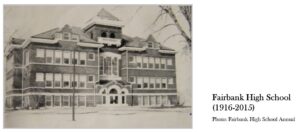
CREAMERIES
The first creamery in the village of Fairbank is believed to have been established in May 1880 by Chester Smith, and eventually operated by Smith and J. M. Wolgamot (1862-1925). The first secretary of the creamery was A. C. Langley. Around 1920, the name changed to Fairbank Farmer’s Creamery Co.
DEALERSHIPS/IMPLEMENTS
— John Rechkemmer’s three sons—Bill, Phillip, and Claire—took over the business and ran it as Rechkemmer Bros. Implement until 1913, when they split it up: Bill took over the Ford and Jewitt car sales, at one time employing five people; Phillip took over implement sales; and Claire was a business partner from 1931-1937 in the Chevrolet franchise with Earl Bentley, B & R Motor Service, under operations in the old Duffy building at the southwest corner of Second and Main Streets.
— B & R Motor Service, according to an article in the Oelwein Daily Register, “was established by Earl E. Bentley, who owned the franchise for Chevrolet sales directly or indirectly since 1928, after working in garages in Fairbank for 14 years [W. P. Rechkemmer]. In 1927 he set up a garage in partnership with Claire Rechkemmer in the old Duffy building [at the southwest corner of Second and Main Streets]. The B & R motor service moved to the location of Bentley Chevrolet [120 East Main Street] in 1933, where the firm operated a garage and filing station for three years. In 1936, Rechkemmer left the firm, and Bentley sold the filing station, continuing the operation of the garage. In 1939 the building was sold to Bentley Chevrolet… .
— Durham Implement: In 1935, Frank Durham bought the implement dealership, renaming it Durham Implement. Corn and soybeans were bought–the corn was sold to Piper Grain and Milling Co. in Cedar Rapids. Frank also sold coal, along with John Deere equipment and parts. Some of the employees who worked for Frank were: Harold Greybill (hauled coal), Ed Jolley, Jimmy Lamb, Ed Oelendorf, Cliff Brant, Beahner Finch, and Leo Strempke. Richard Shields bought the building in June 1960.
— Lewis J. Miller Implement was started by Lewis J. Miller (1887-1961) who came to Fairbank in 1934, after owning a lumber dealer in Salem, Ore., along with his brother, W. E. Miller. The business offered International Harvester farm implements, sales, service and repair, refrigerators and home freezers, and Coleman oil heaters. For a time, the business was located in the old Duffy building at the southwest corner of Second and Main Streets. Brud Miller (son of Lewis J. Miller) operated L. J. Miller Implement from 1946-1963, according to Brud’s obituary.
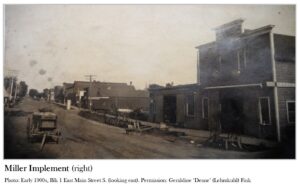
DOCTORS/PHARMACISTS
— Dr. George C. Eickelberg (1867-1940), Dentist: Since graduating the Iowa School of Dentistry in 1898, he occupied space above the Fairbank State Bank building at the northwest corner of Second and Main Streets. He was a big man and sang bass in the Methodist Episcopal Church choir. Upon his retirement about 1937, Dr. F. T. Plas took over the business, the last time the town had a resident dentist. Plass was a 1937 graduate of the University of Iowa School of Dentistry.
— Dr. Paul T. Logue (1871-1937), physician and surgeon: He began his practice in Fairbank around 1926 and served the community until his death (cancer). His last office was the Fairbank State Bank building at the southwest corner of Second and Main Streets.
— Dr. Edward Molloy (1868–1927), physician and surgeon: He had his office above the furniture and undertaking business at Second and Main Streets. He was married to Ella Leehey (1881-1910), daughter of John Leehey (1841-1924) and his wife, Ellen O’Connor Leehey (1845–1922), of the Leehey’s Cash Store family operating at the corner of First and East Main Street. Dr. Molloy was a member of The Bremer County Medical Society, according to The History of Buchanan County, p 534.
— Dr. Joseph Henry Murphy (1849-1928), physician and surgeon: He was born in Hartford, Connecticut to William and Winifred Nolan Murphy (1826-1851), and came to Fairbank in May 1890 from Clermont, Iowa. He had his residence and office at the first door north of the Davis block, east of Citizens Bank He died in his home and was buried in the Catholic Cemetery.
— Dr. Leon Nuss (1926-1998): He was a chiropractor and lived and served the Fairbank area for 44 years. He officed out of his home in the fifth block of East Main Street. He and his wife Darlene (Green) Nuss are buried in the Fairbank Cemetery.
— Dr. A. B. Ward (1832-1879) was born in 1932 in New Lisbon, Ohio, where he resided with his parents until, while still quite young, he commenced the study of medicine under Dr. Parsen, with whom he remained for about 3 years. He practiced medicine in Rockport, Ohio. Then he attended the medical department of the University of Michigan at Ann Arbor, until he graduated. He served Center Point, Iowa 1-2 years before coming to Fairbank in 1855, which he found to be a flourishing little village and where he decided to remain and make this “field his future labor.” His obituary recalls the years he set about “doing the dangerous business of sick calling in the countryside…when Indians and bandits and chicken thieves were his patients and enemies.” He learned to always carry a revolver. He served the Fairbank community until his death at age 57 of consumption, from which he suffered a long time. His son Dr. G. “Griffy” B. Ward took over his practice about .

—Dr. G. “Griffy” B. Ward (1856- 1923): The only child of Dr. A. B. Ward and Maria J. Smith Ward (1836-1907) carried on the profession for 45 years, doing pioneering work in surgery in the state—the first in eastern Iowa to do an appendectomy. He was elected president in 1897 of The Bremer County Medical Society, according to the History of Buchanan County (p 534). In 1904, during a meeting at the Gedney Hotel parlors in Independence, Dr. Griffy Ward was elected as a delegate to the State Medical Convention. Many accredited him the best physician in Buchanan County. His son, Dr. Loraine Ward, took over serving the people of the Fairbank area, plus he served as physician for the Chicago Great Western railroad in Oelwein. Another son, Dr. D. W. Ward (1882-1945), located in Oelwein, and remained there until his death.
— Dr. Loraine W. Ward Sr. (1885-1969): He became the third Dr. Ward to serve Fairbank. He attended Drake and the University of Iowa medical school, receiving his degree in 1913, then interning at Montreal General Hospital, Canada. On Oct. 21, 1933, he married Grace Edwards (1906–1977), a schoolteacher from Blairstown. The couple had two sons, Dr. Loraine W. “L. W.” Ward Jr. (1934–2019), who settled in Cedar Rapids, Iowa, and Robert E. Ward (1939–1939). In 1945, at the end of WWII, he relocated his practice to Oelwein. This was the last time Fairbank had a resident physician.
— Dr. W. W. Wilson, veterinarian: He practiced veterinarian medicine in the Fairbank area from 1907-1963. His residence was in the southwest corner of Indian Town/City Park in the Patterson addition.
— Dr. Edwin Wiltse (1851/52-1932): His family — Dr. Alexander Wiltse and Phebe Wiltse, plus 2 siblings — immigrated from Ontario, Canada in the late 1840s and initially settled in the Delhi, Iowa area, before relocating to Strawberry Point. Edwin graduated Bennett College of Eclectic Medicine and Surgery in Chicago, Illinois in 1874 (the same college from which his father, Dr. Alexander Wiltse graduated) and began his medical practice in Fayette County. In 1877 he relocated his practice to Fairbank in Hotel Wiltse, built by himself and his bride, Lucy Ann (Dean) Wiltse. The couple married in 1873. The hotel was built with wood hauled in my horse and wagon from Wisconsin, as the railroad had not yet come to town. Dr. Edwin Wiltse served the Fairbank community for about a decade before relocating to Canada. The 1910 U.S. Census lists Lucy as divorced.
— Clara Fenne (year-1952), pharmacist: She operated a pharmacy initially in a portion of the old King Bros. Grocery building, until she and her husband, A. O. Fenne, purchased the M. J. Collins Drug store in 1917, calling the business Fairbank Pharmacy. She attended Des Moines University for two years and registered in pharmacy in 1926. When she retired in 1946, the town never again had a pharmacist. She died on Dec. 13, 1952,
The first druggists included: Wallace M. Higbee and Frank David, who operated a pharmacy out of the eastside of Leehey’s Cash Store. John Michael Collins (1859-1915) operated M. J. Collins Drug.
INDUSTRY
— ENDGATE GUIDE CO.: Walter Fred Zewiske (1895-1965) started the business on a farm south of Fairbank; later he moved the business into Fairbank, then to a location on the west-end of town. In the 1920s, he received a patent for a guide on a wagon box. Besides the guides, he specialized in truck boxes, pick-up racks and other farm tools. Zewiske built the first wooden school bus for Westgate, Iowa in 1929. He received a patent on a pick-up rack in 1961. After Walt died, his son Lavern took over the company
FIRE DEPARTMENT
— Before the first bridge (1865) was built across the Wapsipinicon River, the village had a volunteer fire department for each side of the river. The first fire equipment was a hand-pumper, requiring two men on each side to pump in order to get pressure. Later an old steam pumper was purchased from Waterloo, Iowa, called the Jenny Jule.
In January 1901, the town incurred a significant fire, according to an article in the Oelwein Daily Register, when nine businesses in the first block of town on the east side were wiped out. Fireman Frank D. Miller (1915–1984) ordered several businesses torn down to keep the fire contained. Two men suffered near-fatal injuries. The loss was estimated at $15,000.
On February 6th, 1902, a group of men met to formally form the Fairbank Fire Company in Dr. George C. Eickelberg’s office. Members included: Dr. Eickelberg, Frank Ward, Chas. Massey, F. A. Klinger, V. Reisner, F. H. Lehumkuhl, Levi Finch, W. W. Gallup, Fred Kraft, Henry Schmeekl, E. B. Chandoin, P. E. Damge, and J. M. Wolgamot (1862-1925).
The following year a cistern was built in the center of East Main and Second Streets to collect rain water for fighting fires. Eventually, a water line was dug in along East Main Street, the cistern filled-in, and a flag pole was placed in a cement base in the middle of Main Street.
The first F. F. D. building was located on a lot next to the river on the east side. In 1929 the town erected a new city building, jail, and engine house, and installed a new water system around 1931, including the first water tower.
Fire chiefs have included: Dr. G. C. Eickelberg (1902-1903); F. H. Lehmkuhl (1904-1906); Dr. G. C. Eickelberg (1907-1913); no record, but this could be Frank D. Miller (1914-1944); Kenneth Betts (1945-1952); Joe Miller (1953-1956); Bob Maricle (1957-1959); Ray Weber (1960- 1974); Don Brandt (1975-1988); Dave Redl (1989-1990); Ron Miller (1991-1992); Don Brandt (1993-1995); Steve Welter (1996-2004); Ed Gipper (2005-2006); Dave Ryan (2007-2012); and Kevin Bodensteiner (2013-2016).
FURNITURE & UNDERTAKING
— John M. Youngman Furniture & Undertaking: Youngman’s business was initially located in a building at the northeast corner of Second and Main streets. Previous owners of the property were Emil J. Schumacher; also M. .J. Collins & Co. who sold drugs, paints, oils, books, wallpaper, picture framing–and undertaking. On January 31, 1916, Youngman moved his business to a second site: the two-story building across the street, where he sold pianos, tables, chairs, rockers and other pieces; coffins were located on the second floor (Hintz Funeral Home in Oelwein did the embalming). Eventually Youngman relocated the business to a third site: the east side of Leehey’s Cash Store at the corner of First and Main streets. The building at the second site was eventually torn down, and in 1953 Earl Bellis and Robert D. Maricle purchased the land, and moved a building from Hazelton, then started the Bel-Mar drive-in. On Mar. 12, 1965, they sold it to John Ford, who later sold it to his brother Paul Ford. Today the property at 210 E. Main Street is currently a business called Brainard Hollow.
GAS STATIONS/REPAIR
— B & R Mobile, part of the Chevy dealership on the southwest corner of Second and Main Streets.
— Bud Chase: had a little station (located beside his house) about a block south of Cash’s Phillips 66 (west of the I.C. Catholic Church). After the station closed, it became a car wash.
— Cash’s Phillips 66: Owned by Cassius Ward (1902-1982) and his wife Mildred E. Ward (1903-2000) was located at the northeast corner of Walnut Street. N. (west of I. C. Catholic Church). It included a lunch counter and had an icehouse behind (east) the structure.
— Fink’s Conoco: was owned by Leo Fink, (1896-1968), located on the north end of Fairbank. The family lived in a small house behind the pumps.
— Minton Sinclair Gas: Jacob Minton (1861-1941) and his wife Lucy (Dean-Wiltse) Minton (1854-1933) owned the filling station west of the Wiltse Hotel (built in 1877 by Lucy and her first husband, Dr. Edwin Wiltse). It is said that Jacob hand-pumped gasoline at six gallons for a dollar; sold kerosene for forty cents a gallon; and pumped oil from a barrel, a quart costing fifteen cents (an oil change for a Model T or A requiring six quarts). Waiting patrons enjoyed free fresh popcorn from an electric machine inside the station, or enjoyed a small bottle of Coca-Cola, Pepsi, grape, orange, or ginger ale for five cents from the tall red vending machine in front of the station facing East Main Street.
— Murphy’s was owned by Billy Murphy, located at Second and Main Streets. It’s believed the previous owners, George and Erseline T. Murphy, added the gas station around 1934.
— Park Gas was owned by Phil Riggs (1902-1972), operated by Leo Peters (1895-1946), and located on the southwest corner of Fourth and East Main Streets. At that time, gas pumps were the type pumped by hand. In 1933 Shirk Oil Co. from Oelwein purchased the building and changed it to a Texaco station. Louie D. Peters (1923-1997), Leo’s son, went into business with his father in 1946, then they sold the station to Bernard “Barney” Ohl (1923-2008) the following year. Barney’s father John Ohl (1899-1988) managed the business. John had been the lead mechanic for the Earl Bentley Garage for many years. They renamed the business Ohl’s Texas Service.
— Ralph’s DX: The property at the corner of Second and Prosperity Streets (later renamed Grove Street) was initially a livery (Murphys’ Livery), which in its heyday housed eight horses, six carriages, and four cutters. Over the years the property changed hands numerous times. In 1938 Arnie Simonson (1900-1964) purchased the property from L. R. Banham. Miss Mabel Curtis was hired to take charge of the filling station, while Simonson continued with the repair shop in the garage. The station sold City Service Oil Products and Koolmotor Gasoline, tank service provided by Herman Fettkether. Simonson sold the property in 1964 to Ralph Chase (1928-1994), who named the business Ralph’s DX. The station was still in existence as late as 1976.
GRAINERY/ FEED Mill
— Agnew Grain Co. was established in the early 1900s. In 1920 Ralph Emerson renamed it Emerson Grain Co. F. (Frank) A. Durham (1890-1962) managed the property. The business, located south of the railroad depot, sold John Deere corn binders, plus a complete line of machinery; also, coal—lump, furnace, and egg size. Corn and soybeans were sold to Piper Grain and Milling Co. in Cedar Rapids. Frank and his wife Mary Ellen McCunniff Durham (1918-2003), had one son, Emmett Aderman Durham (1915-1978). People who worked for Durham at various times were: Harold Greybill (hauled coal), Ed Jolley, Jimmy Lamb, Ed Olendorf, Cliff Brant, Beahner Finch, and Leo Strempke.
— GRIST MILL (‘Old Mill’): The first grist and flouring mill was built by Naylor and Harrington in 1855 on the northeastern bank of the Little Wapsipinicon River next to the dam and later became the property of Jacob I. Minkler (1830-1904) and F. W. Nichols (1833-1923). It’s believed J. G. Hovey aided in the construction in 1854. The property included land on the east side of the river, where the mill stood, and land on the west side of the river adjacent to the dam.
For a time, the mill was managed by G. A. Oelwein, as the obituary of Mrs. (Emma Schmidt) Oelwein states in 1865 they came to Fairbank and were engaged in the milling business, before relocating to Oelwein and building their own mill 2.5 miles south of town, today known as Oelwein City Park. According to The History of Buchanan County, 1816-1902 (p 341), the Fairbank mill was lost in 1865 during spring flooding.
The re-built mill, renamed Fairbank Milling Company, was operated by ‘Fatty’ Paine in the 1920s-30s. Robert Bentley (1895-1970) and Bill Crook took over the mill after the Wall Street crash in 1929. On April 29, 1935, Robert Bentley deeded the mill property to the town, except the land on which the mill stood. A fire destroyed the mill on August 1, 1943, and was never rebuilt. On June 9, 1945, the remainder of the property was deeded to the town by Robert and Mildred Bentley. Today, the only business on this block is Costa’s Sports Bar & Grill.
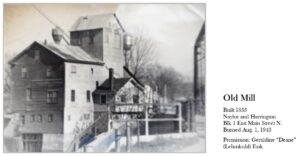
— Myers Feed and Grain Elevator Co., established in 1937, initially began as Myers Feed and Milling, owned by Bernard “Doc” Myers (1914-1997). The business was located along the railroad tracks, just south of the Chicago Great Western Railroad depot. He added a portable mill which he drove farm to farm grinding feed in the 1940s-1960s.
GROCERY/ MEAT/PRODUCE
— Curley’s Meat & Grocery was established in 1903 by James M. and Anna ‘Kitty’ (Mealey) Curley, which began as a slaughterhouse, known as ‘Old 20.’ Jim hired men from town to cut big chunks of ice from the river and bring it to the ice house, located behind the store, to keep the meat cold year-round. Sprinkling the ice with sawdust helped the ice last until the following January. Eventually, groceries were added to the store. Jim died in 1935, and the store was taken over by Russell Curley and Katherine (Curley) Kemp. In 1942 a locker operation was added by Russell; when he died four years later, the business was taken over by his wife, Mary.
— King Bros. Grocery: In 1883, Sidney King arrived in Fairbank and engaged in the produce business on the west side of the divided building at 109 E. Main Street (Clara Fenne operated a drug store on the east side). Sidney died in 1917, when Sidney’s sons, Percy and Hayes (O. H.) King, took over the business. In 1921 groceries were added. After Clara Fenne relocated her business to the O’Conner building in 1930, the two sides of the building were combined to house the grocery business, and the produce was discontinued. Percy died in 1940, and Hayes operated the store until his death in 1945; then his wife, Blanche King, ran the store with the help of her son, Bill King. The store closed when she retired in 1959.
— Peters Grocery was a grocery and meat establishment, operated by Joe (1889–1952) and Dollie (Roquet) Peters (1909-2008). She ran the store; Joe operated the meat establishment and a truck delivering milk to the townsfolk, and groceries to farmers and the Amish. After Joe’s death in 1952, she sold the property and became employed at Fareway in Oelwein, according to her obituary.
— Chase Produce: Earl Chase purchased a produce business in the 1940s from a Smith and ran it for several years out of a building across from the former Brick Hotel building on East Main Street. Earl drove a truck around the area to pick up eggs from farmers. In addition to candling and selling eggs, he sold feed and other products.
HARDWARE/ PLUMBING & HEATING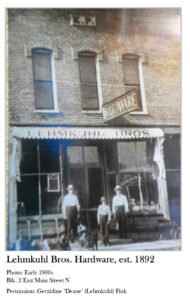

— Lehmkuhl Bros. Hardware was established in 1892 by Fred H. Lehmkuhl (1872-1934) and several of his 7 brothers, located on the west side of the Fairbank State Bank building at the corner of Second and Main Streets. Eventually, they added a large storage building north of the bank.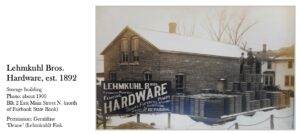
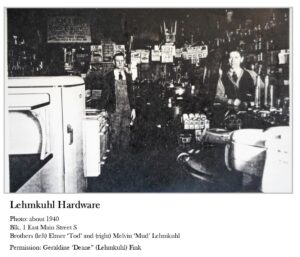
— Miller Plumbing & Heating: In 1916 L.T. Miller and son, Frank M. Miller (1894-1970), purchased Lehmkuhl-Fratzke Hardware from John H. Lehmkuhl (1880-1912) and Fred A. Fratzke (1881-1961), renaming the business Miller Hardware. In 1946, Joseph W. Miller (1918-2013) purchased the building and was employed in the firm. In 1956 Joe bought one-half interest in the business, and in 1964, upon Frank’s retirement, Joe became sole owner of the business located at 117 Main Street. He tore down the building in 1976 (along with the old Fred Monroe Insurance Agency building he’d also purchased next door) and built a larger building to house the plumbing and heating business, adding rental apartments on the top floor.
— William H. (Bill) Miller Hardware & Repair (hardware, shoes and harnesses repair) was established in 1930. Built in 1864, the building once housed a store and restaurant operated by Valentine Peter and Elizabeth Hahn from 1868–1929. Bill ran the business until 1952, when his wife died and he moved the shoe repair business to the basement of his home, then Joe Miller purchased the building.
— E. A. Weibel Hardware, owned by Emil A. Weibel, sold heating, hardware and plumbing supplies. The oil ranges were advertised: “cooking as fast as gas.” DeLavel cream separators were big sellers, too. It’s uncertain when the business closed, but in the mid-1930s, Clarence B. Everett, Fairbank State Bank president, hired W. B. (Bill) Lehmkhul to help close out a hardware store, and it’s believed this may have been Weibel’s store. In the late-1940s-1950s, it’s believed Uthy’s Grocery operated at this location.
HOTELS
— The Brick Hotel is believed to be the oldest hotel in the township, built around 1854 by either/both Frederick Patterson or Mr. Wolgamont. In the 1920s, the property was owned/operated by S. A. Coffin (on a couple occasions). The hotel ceased operations in the late 1930s. In the 1940s, it housed a monument business operated by Charles Fink. Around 1911, the Home Telephone Co. relocated to the east side of the Brick Hotel. In 1928, Albert Bentley sold the business to Associated Public Utilities Corp. Martin Klenzman operated Klenzman’s Cleaning Shop on the west side of the building in the late 1940s.
— Hotel Wiltse was built in 1877by Dr. Edwin Wiltse (1851-1932) and Lucy (Dean) Wiltse (1854-1933), who had the lumber hauled in from South Dakota and Wisconsin by wagon, as the railroad had not yet come to town. The couple had married in 1873. The History of Buchanan County, Iowa, Williams Bros. Publisher, 1881, noted: “The Wiltse Hotel at Fairbank is known to the traveling public as one of the better class smaller hostelries of the state.” Lucy and Dr. Wiltse divorced by 1910, according to the U.S. Census.
LODGES, CHURCH & CIVIC ORGIZATIONS
— The lodges of Ancient Free and Accepted Masons, Knights of Pythias, Modern Woodmen of America, Mystic Toilers and Relief Corps were all represented in Fairbank with full memberships–the Masons, Fairbank Lodge No. 148, being the strongest, with about eighty members; other clubs and groups included ladies from the churches and those from the township. From as far back as 1930, the town’s Commercial Club collected twenty-five dollars annually from each business, used to give turkeys to the homebound and needy at Thanksgiving; bagged candy to children during visits to Santa at Christmastime; and treats at Easter, including Easter egg hunts on the Island Park.
LUMBER YARDS/CONSTRUCTION
— Chapman Lumber Yard: Originally two lumber yards existed: Colgrave Sylvestor Co. at 102 N. Fourth Street, and Chapman Lumber Co. located near the railroad tracks. Chapman bought out Colgrave sometime around 1910. The business offered a comprehensive line of lumber and building material, cement, plaster, lime, building blocks, brick, tile, steel gates, fending and posts, roofing, stucco and barn equipment. The yard occupied the entire block at Fourth and Main Streets, and all materials were housed under shed. Frank Klinger managed the yard for a time; Charlie O’Donnell ran it from 1941-1966, continuing after the business was sold to Midwest Lumber Co.
— Hein Bros. Construction was established in the late 1940s by brothers Martin and Otto Hein, following Otto’s return from service in WWII. Martin was killed in a work-related accident in June 1964; Otto continued the business until his retirement. The firm employed an average of 4-6 employees (Harold Schmitt as a long-time employee) and the business was capable of building a structure from concrete foundation to finish trim, at a time when it was still allowed to do electrical and plumbing as a general contractor.
— Woods Construction Inc. and Modern Building Products was established in 1965, located at 505 2nd St. NE, by John and Sharon Woods. In 1985 Woods Construction Inc. was purchased by son, Ronald Woods; Modern Building Products was purchased by son Richard Woods. Modern Building was moved to the present location at 511 4th St. N. Both businesses are presently operating.
MERCANDILE/MILLINARY
— Leehey’s Cash Store: In 1902 two brothers—M. (Michael) E. ‘Bee’ Leehey (1877- March 12, 1961) and J. T. (Joseph) Leehey (1879-1929)—purchased the 3,000 sq. ft. mercantile store from F. J. Everett (1829 -1898) & Co., at the northeast corner of First and Main streets. Supplies arrived by stagecoach that followed a route in the southern part of the township called Kier. F. J. Everett, who founded the mercantile, operated the store for over 40 years until his death. The eastside of the building was used as a drug store (Wallace M. Higbee and Frank David were among the first druggists).
— O’Conner’s: The lot where O’Conner’s operated was initally owned by Milton Harrington (June 6, 1855). He sold it to Sarah McCunniff on March 14, 1856. The property changed hands several times in the next several years: John and Sarah McCunniff to F. C. Patterson on Jan 21, 1858; F.C. Patterson to Jane Kilgore on Feb 1, 1858; Jane to John Rechkemmer on Oct 28, 1863; John to E. F. Kurt on May 27, 1882; Kurt to Martin LONG on Jan 10, 1885.
John O’Conner (1869-1959) and his wife (Anna 1879-1955) purchased the building/business on December 17, 1919, selling dry goods, notions—staple and fancy groceries, flour seed and queensware, and handled produce of all kinds. Shoes, hats and caps, work shirts and overalls were located on the balcony.
— Lacey & Nichols Millinery was located on south Main Street between First and Second streets, believed once owned by Helen Bentley’s parents [Earl], who resided in the building, along with W. Nichols. At one point the business was named Walgamot Millinery, also Weaver Millinery at one time.
NEWSPAPERS
— The Fairbank View/ The Four County Advocate (1886-1931): Fairbank published an ongoing newspaper for 45 years, under the names: The Fairbank View (1886-1919); The Four County Advocate (1919-1931). Initially, the newspaper was housed in a building across from the Brick Hotel between Minton Gas and a produce store. Sometime after Charles Grantham purchased the paper (and Opera House at First and Main streets) around 1921, the newspaper relocated to the first floor of the Miller Opera House at the northwest corner of Main and First Streets. The paper closed soon after the 1929 Wall Street crash.

Opera House/ Theatre & Billiards
— The (Miller) Opera House was built in 1894 at the corner of First and Main Streets. Stage plays regularly rotated to area theaters, and on weekends the place was the destination of people from miles around—Oran, Klinger, Otterville, Stanley, Dunkerton, Jesup, Littleton, Hazelton, and Readlyn. Additionally, local groups utilized the upper floor to show reels on ‘Cooperative Marketing,’ etc.—and for wakes. Irish ones were epic all-nighters, with lots of liquor consumed. One story that turned legend was of a cadaver being removed from the coffin, placed upright in a chair in a corner, while the grieved took turns climbing into the coffin themselves. In 1921 Charles Grantham purchased the property and relocated the town’s newspaper (Fairbank View) printing equipment to the first floor. On the upper floor, he showed silent movies then ‘talkies.’
Theatre/Billiards/Bowling
— Initially a Theatre & Billiards business, located on the east side of the old Post Office building on the south side of Main Street, was operated by John F. Fettkether. At some point, it included a bowling alley begun by Hugh Leehey (1883-1966), which offered two lanes of duck pin bowling. Life-long resident, Verlie Hahn (1916-2018), in an interviewe at 100 years of age, recalled “walking downtown and hearing the sound of bowling balls striking wooden bowling pins.”
— Polly/Fairbank Theater: Its location or management is uncertain, but it was still in existence in 1924 when ‘The Way of Man’ and ‘America before the Civil War’ were shown.
— Pen-Air Theatre: Its location is believed to have been east of the old Post Office (then Lehmkuhl Hardware) building on the south side of Main Street, that included a permanent screen where moving pictures were shown on Wednesday and Saturday nights, at a cost of fifteen cents. If there was rain, the movie was postponed until the following week. The Pen-Air was managed by Charlie Grantham and in existence at least through 1925, when ‘Empty Saddle’ was shown.
OTHER ENTERTAINMENT
— The Circus came to town most every summer from the early 1900s to the mid-1940s. Its monster canvas tent was set up near the railroad depot at Fifth and Main Streets. A huge announcement was pasted on the side of the two-story M. J. Collins & Co. building on Second and Main Streets, plus flyers graced store front windows. The circus was likely a smaller version to the one that annually set up in Oelwein, featuring “two bands, drum corps, 50 actors, dancers, specialty and colored people, a herd of Shetland ponies and donkey, and a pack of ferocious Siberian blood hounds.” Usually the circus was in town for one day only. Locals were hired to help set it up and tear it down.
— Four County Corn Show: Founded in 1919, the show was always held in February and at the Fairbank High School. It quickly grew to involve four counties: Black Hawk, Bremer, Buchanan, and Fayette. The first show only included a very small display of a few ears of corn. In 1921, the show expanded, with women making an effort to promote their items: fancy works, baking, quilting, caning, etc. Eventually a Friday musical amateur night, Saturday Home Talent night, and one-act play were added — plus, other items for display and sale: vegetables, rugs and crafts. Prizes, ribbons and money were given to winners. The Fairbank Tourist Club always hired a speaker for the show. In 1951 and 1952 there was no show, then it was revived for one year before it ceased.
— Fairbank Days began in 1939 as an annual event initially held on August 15th. The event included a small circus, carnival rides, and local food vendors; a large parade down Main Street made up of home-made family and business floats, area school marching bands, Veterans of Foreign Wars, and farm and tractor units.
PHOTOGRAPHERS
— Pioneer professional photographers in Fairbank included Edwin E. Everett (son of C.B. Everett) and Heine W. Wieser, who first had his office in a building just east of the Wiltse Hotel, then he moved his office above the Fairbank State Bank.
RAILROAD
— In 1887, the Chicago, St. Paul & Kansas City Railroad came to the village of Fairbank—the first year passenger service began, according to the Hub City Heritage Corporation Railway Museum, Oelwein, Iowa. In 1892, the Chicago Great Western (CGW) railroad became its successor. Train derailments were not uncommon in the early years of the railroad, such as one recalled at the turn of the nineteenth century, when, loaded with passenger from the New York, the train left the tracks west of Fairbank. The porter had to walk several miles to the depot to alert the agent of the mishap, so he could alert other trains on the line by telegraph.
The train was the cause of human casualties, including two in one family. In October 1919, Sophia (Elert) Lehmkuhl, 82, was struck and killed by a train late while walking across the tracks at the Fourth Street crossing by the Baptist church on her way home from downtown. Then in August 1944, Dale Lehmkuhl, 3, son of Melvin ‘Mud’ and Vera Lehmkuhl, was killed while playing on the tracks south of his uncle, E. G. ‘Tod’ Lehmkuhl’s gas station (formerly the Bon Ton).
STOCKYARDS
In 1914, John Gardner purchased the stockyards south of the railroad depot. Other owner-operators included: Arlie Martin (1941); Richard Shields (June 1959)—who also brought F. A. Durham Implement in June 1960, later dismantling the businesses.
TAILOR
— A tailor shop in the 1920-1930s occupied the north end of the Telephone Exchange Co., operated by Bill Kern. Ludwig Mueller (1840-1906) may have been the previous owner; he drowned in Leg’s swimming hole behind the Frank Mathews’ farm.
TELEPHONE/ELECTRICITY
— Telephone Exchange Co.: In 1895, the town of Fairbank was added to the system of the Iowa Telephone company. In the early 1900s, John Shannon, who operated a small bicycle shop by the Wapsie river south on Main Street, ran a telephone line from the shop to his home about three blocks east. Soon other businesses connected to the line. Initially it was called the Home Telephone Co., and Mary Shannon, John’s wife, was the operator. After John died in 1911, it was purchased by Albert Bentley and son, who relocated it to the west side of the Brick Hotel, also run by Bentley—then by Bob and Mildred Bentley. Ida Rechkemmer, Blanche Miller, and Adoline Steggall also worked the switchboard.

In 1928, Albert Bentley sold the business to Associated Public Utilities Corp. Dial telephone came to Fairbank in 1953.
— Electricity: The town got electricity in 1916—when more poles (telephone poles appeared first) emerged along Main Street with glass insulators on the tops and cross-arms, adding further to the tapestry of Main Street.
U.S. POST OFFICE/MAIL CARRIERS
— The first U. S. Post Office was established in Fairbank in 1854, with C. W. Bacon appointed postmaster, operating out of a little log cabin built by himself and F. S. Everett. Eventually, the post office relocated to the south side of Main Street in Fairbank, between First and Second streets. Sidney K. King served as postmaster from 1893-1897. In 1934 the Post Office moved to its current location at 201 E. Main Street (former M. J Collins & Co. building).
Fred Patterson began serving as mail carrier in 1903, once a week traveling to Independence to pick up mail, then daily driving some fifty miles delivering mail to farmers in the area.
WELL-DRILLING
— Dem Mersch relocated his well drilling business to Fairbank in 1922, started in the late 1890s in the Readlyn area.
— — — — — —
AMISH MENNONITES
— The first group of seven Amish families to arrive in the Fairbank area broke away from the religious sect in Johnson County by Cedar Rapids, Iowa around 1914. A second group of 39 Amish arrived in Fairbank by train in May 1936, after oil had been discovered on their farmlands in Kansas. Although the they had an opportunity to reap a rich harvest, they refused to extract full advantage of the situation, selling their farms for only $100 an acre.
— — — — — —
BUCHANAN COUNTY SHERIFFS
— F. H. Lehmkuhl (1914-1920); F. T. Bushby (1920-1924); Harry Willey (1924-1930); Ray A. Burch (1930-1932); A. W. Hammelman (1932-1940); James L. McDonnell (1940-1942); Kenneth H. Miller (1942-1946); Emery A. Hart (1946-1964); Fred W. Beier (1964-1972); Joe Holgate (1972-1977); John Bergman (1977-1978); Duane Domer (1978-1980)